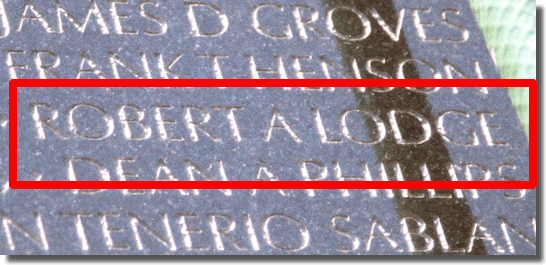
Further Details
 In the spring of 1972, the U.S. formulated the LINEBACKER offensive. Its objective was to keep the weapons of war out of North Vietnam. At this time, the North Vietnamese had one of the best air defense systems in the world, with excellent radar integration of SA-2 Surface-to-Air Missiles, MiGs, and antiaircraft artillery. The NVN defense system could counter our forces from ground level up to nineteen miles in the air. MiG fighters were on ready alert, and after takeoff, were vectored by ground-control radar. Soviet advisors devised attack strategies, manned a number of the SAM sites, and also trained North Vietnamese crews.
In the spring of 1972, the U.S. formulated the LINEBACKER offensive. Its objective was to keep the weapons of war out of North Vietnam. At this time, the North Vietnamese had one of the best air defense systems in the world, with excellent radar integration of SA-2 Surface-to-Air Missiles, MiGs, and antiaircraft artillery. The NVN defense system could counter our forces from ground level up to nineteen miles in the air. MiG fighters were on ready alert, and after takeoff, were vectored by ground-control radar. Soviet advisors devised attack strategies, manned a number of the SAM sites, and also trained North Vietnamese crews.
On the first strike day, 10 May 1972, a strike force of 32 F-4s launched against the Paul Doumer Bridge and the Yen Vien railroad yard near downtown Hanoi. The North Vietnamese strongly defended these targets, firing a large number of SAMs and sending 41 MiGs to intercept the U.S. attackers. After shooting down a MiG-21, one of the F4D MIGCAP aircraft was shot down by one of more MiG-19s near Yen Bai, North Vietnam. Maj. Robert A. Lodge was the pilot of the F-4D, callsign Oyster 1. His Weapons Systems Officer (WSO) was Capt. Roger Locher. The aircraft was observed to be on fire during descent, and impacted the ground in a ball of fire. No chutes were seen or beepers heard from either crewman. This crew had shot down two MiGs the previous week.
On June 1, an F-4 on a mission in the area reported a beeper and voice contact with a downed crew member in the vicinity of Yen Bai, North Vietnam. Search and Rescue (SAR) forces were immediately diverted to the area and established radio contact with the WSO, Capt. Locher. Minutes later helicopters arrived in the area. By this time, the A-1s defending the rescue were receiving heavy anti-aircraft fire. The A-1s had not been able to pinpoint Capt. Locher's location, and the helicopters, equipped with electronic location finders (ELFs), attempted to pinpoint his position. At this point a MiG-21 made a high-speed, low-altitude pass at the helicopters, followed by another pass within minutes. The helicopters were low on fuel, and it was decided to suspend rescue operations for the day. (Note: Rescue was being attempted within 7 miles of Yen Bai Airfield, a very strongly defended area and extremely dangerous for the rescue attempt.)
It had been three weeks since Oyster 1 was shot down, and it seemed unlikely that anyone could evade capture against such heavy odds. It was suspected that a captured POW was being used by the North Vietnamese to lay a trap for the SAR forces. Despite the possibility of an ambush, the SAR operation resumed the second day.
Operations on the second day began with a diversionary strike against Yen Bai Airfield. Other F-4s were used to hit anti-aircraft guns in the area. The rescue package and the bombers, plus the attendant array of F-4 escorts, EB-66s, F-105G Weasels and KC-135 tankers totaled 119 U.S. aircraft – more aircraft than had been involved in the original 10 May attack on Hanoi when Locher was shot down. As the helicopters entered the rescue area, they picked up strong radio signals from Locher. The A-1 escorts were receiving heavy AAA fire and called in more F4 strikes against the guns. The SAR helicopters, to avoid SAMs and MiGs, flew at an altitude of about fifty feet (all within 3-7 miles of the enemy airfield). As they approached Locher's position, they began taking heavy ground fire from the many villages in the area.
The ELF equipment proved to be particularly valuable, as its signals directed the helicopters right to Locher. A jungle penetrator was lowered, and Locher brought on board under heavy ground fire. It was not until Locher was actually onboard that SAR forces knew for certain that the rescue had not been a trap.
Roger Locher had walked about twelve miles from where he had parachuted and had kept himself alive on wild fruit and weed shoots. The many streams had provided him a plentiful supply of fresh water. The extent of the SAR effort was indicative of the efforts put forth to rescue downed pilots.
It was believed possible that Robert Lodge had also escaped the crippled aircraft, and he was classified Missing in Action. In 1973, 591 Americans were released from prisons in Hanoi. Robert A. Lodge was not among them. On September 30, 1977, the Vietnamese "discovered" the remains of Robert A. Lodge and returned them to U.S. control.
The LINEBACKER and LINEBACKER II offensives were the most effective strikes against enemy defenses in the war. By the end of these surgical strikes, according to pilots who flew the missions, the North Vietnamese had "nothing left to shoot at us as we flew over. It was like flying over New York City."
(http://www.pownetwork.org/bios/l/l068.htm)
[ My History ] [ Home ] [ Table Of Contents ]